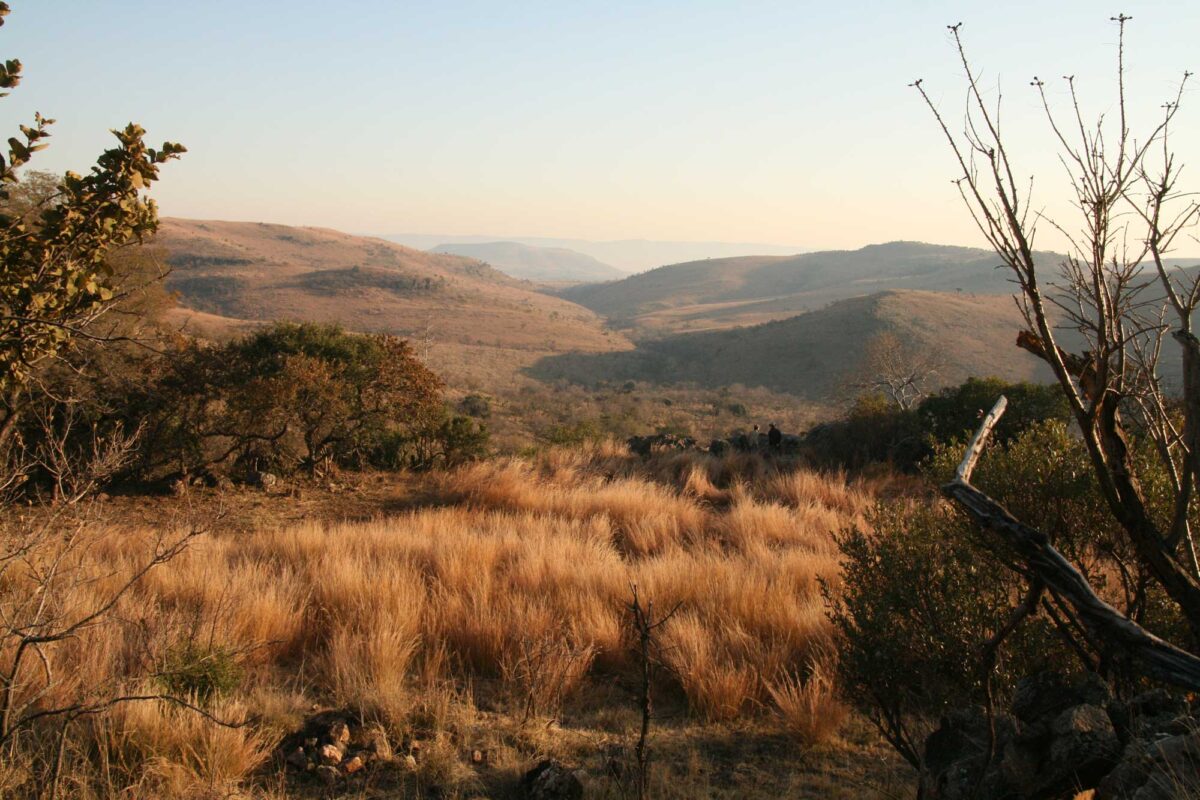Page snapshot: Summary of the early evolution of hominins, including the genera Ardipithecus, Australopithecus, Paranthropus, and Homo.
Topics covered on this page: Introduction; Evidence for ancient environments; Evidence from hominin fossils; Evidence from stable isotopes; Carbon isotopes; Oxygen isotopes; The earliest hominins: Ardipithecus; The emergence of Lucy: Australopithecus; Paranthropus: nutcracker or hominin cow?; Out of Africa: the origin and dispersal of Homo; Resources.
Credits: Funded by the National Science Foundation. Any opinions, findings, and conclusions or recommendations expressed in this material are those of the author(s) and do not necessarily reflect the views of the National Science Foundation. Page by Ryan McRae (2023).
Updates: Page last updated August 24, 2023.
Image above: The Malapa Valley, South Africa, the area where the early hominin Australopithecus sediba was discovered. Photo by Lee R. Berger (Wikimedia Commons, Creative Commons Attribution-ShareAlike 3.0 Unported license, image resized).
Introduction
Human evolution is a topic in the field of paleoanthropology, the study of the origin, diversification, and individual species in the tribe Hominini, whose members are called hominins. The subjects involved in the study of human evolution are very diverse. They include archaeology, which focuses on material remains left behind, like stone tools and beads; paleontology, which is the study of the physical remains of hominins (and other life forms) in the form of fossils; paleozoology and paleobotany, which are subdivisions of paleontology that focus on the animals and plants found at the same sites as hominin fossils; and paleoclimatology, which is the study of the ancient environments and landscapes in which hominins lived. Together, these fields of study allow scientists to gain a holistic picture of who our ancestors were and the types of environments in which they lived.

A stone tool from Boko Dora, Ethiopia. This tool is thought to be about 2.85 to 2.55 million years old. Left: The stone tool where it was found at an archaeological site. Right, top: Four views of the stone tool. Right, bottom: Four views of a model of the same tool. Figure by David R. Braun (Wikimedia Commons, Creative Commons Attribution-ShareAlike 2.0 Generic license).
Modern humans, the species Homo sapiens, are the only living members of the tribe Hominini, a group that was once much more diverse millions of years ago. Members of the hominin group split from their closest living relatives, chimpanzees (Pan troglodytes) and bonobos (Pan paniscus), around 6 to 8 million years ago somewhere in sub-Saharan Africa. Some of the traits that separate hominins from our ape relatives are the ability to walk on two legs, larger and more complex brains, and the ability to make and use tools.

A chimpanzee sitting in a tree, Guinea, 2021. Photo by Aboubacarkhoraa (Wikimedia Commons, Creative Commons Attribution-ShareAlike 4.0 International license, image resized).
One of the original theories for how these traits came to evolve was the Savanna Hypothesis, the hypothesis that early hominins developed the ability to walk on two legs to live in and see over grasses in large, open environments that were different than the closed forests that other apes live in. While support for this theory has waxed and waned over time—since it was likely not so clear-cut—the role of grasses and expanding grasslands are still central to our understanding of human evolution.

African baobabs (Adansonia digitata) on the modern African savanna, Tarangire National Park, Tanzania, 2019. Photo by Yoky (Wikimedia Commons, Creative Commons Attribution-ShareAlike 3.0 Unported license, image resized).
Evidence for ancient environments
Evidence from hominin fossils
One way to gain information about the environments that hominins lived in is by looking at the fossil hominins themselves. Their limb proportions, or how long their arms and legs are, can tell scientists if they were more likely climbing in trees or living on the ground. Longer arms generally means that they were spending more time in trees. The position of the head and spine as well as the structure of the hip and leg joints also tells scientists whether an animal walked on two legs or four. For human evolution, the lack of reliance on trees (shorter arms) and increased reliance on walking on two legs would indicate that they lived in more open environments like grasslands.

Reconstructions of skeletons of three fossil hominins with the actual bones that have been found shown. The skeletons on the left and right are of Australopithecus sediba and come from Malapa, South Africa. The center skeleton is "Lucy," a famous skeleton of Australopithecus afarensis from Ethiopa. Lucy is much older than the other skeletons. Photos by Lee R. Berger, figure compiled by Peter Schmid (Wikimedia Commons, Creative Commons Attribution-ShareAlike 3.0 Unported license).
Evidence from stable isotopes
Carbon isotopes
Another form of evidence is isotopes, different forms of the same element with different numbers of neutrons in the nucleus of the atom. The element carbon, on which all life is based, has two stable forms: carbon-12 (12C) and carbon-13 (13C). Different plants process these isotopes of carbon in different ways depending on how those plants undergo photosynthesis. Plants that follow a C4 pathway include many grasses, whereas C3 plants include most trees, bushes, shrubs, and non-grass herbs (non-grass, non-woody plants). These plants have inherently different ratios of 12C to 13C because of their different photosynthetic pathways.

"The two carbon isotopes commonly used in paleoecological studies: 12C (left) and 13C (right). Carbon-14 is also used, but primarly to date fossils; it is not depicted. Protons are blue; neutrons are green, with a purple outline indicating an extra in the 13C isotope nucleus; electrons are yellow." Figure and caption by Jansen Smith (Digital Atlas of Ancient Life, Creative Commons Attribution-NonCommercial-ShareAlike 4.0 International License).
Oxygen isotopes
Another means of reconstructing past environments is by using the stable isotopes of oxygen (O), the element abundant in water. When the environment is cold, the lighter oxygen-16 (16O) isotope, which can evaporate easier, is trapped in glaciers on land, meaning that there is a higher abundance of the heavier oxygen-18 (18O) isotope in the water cycle. When temperatures are warm, 16O that is locked in melting glaciers is freed and rejoins the water cycle, thus lowering the relative abundance of 18O in the environment. Thus, oxygen isotopes can be used to reconstruct global temperatures.

"The two oxygen isotopes commonly used in paleoecological studies: 16O (left) and 18O (right). Protons are blue; neutrons are green, with a purple outline indicating an extra pair in the 18O isotope nucleus; electrons are yellow." Figure and caption by Jansen Smith (Digital Atlas of Ancient Life, Creative Commons Attribution-NonCommercial-ShareAlike 4.0 International License).
The earliest hominins: Ardipithecus
One of the earliest creatures that is widely accepted as being part of the hominin lineage is Ardipithecus ramidus, which lived from 4.8 to 4.3 million years ago in what is now Ethiopia. This early hominin species is known best from a female skeleton named ‘Ardi’ discovered in 1994. Ardi exhibited some traits linking her to humans, such as hips that indicated bipedal (two-legged) walking, smaller canine teeth, and a skull that rested in an upright posture above the body rather than being held in front of the body like in four-legged animals. However, Ardi still had long arms and fingers like other apes, grasping big toes, and a brain size smaller than that of modern chimpanzees.
Specimen is an artificial cast of an Ardipithecus ramidus skull courtesy of Cornell University in Ithaca, New York. Model by Hannah Teush (Sketchfab; Creative Commons Attribution 4.0 International license).
Specimen is an artificial cast of an Ardipithecus ramidus mandible courtesy of Cornell University in Ithaca, New York. Model by Hannah Teush (Sketchfab; Creative Commons Attribution 4.0 International license).
The way that hominins moved—or their locomotor adaptations—give scientists clues to the environments in which they lived. Ardi retained many ape-like features that made it well-suited to living in and around trees, like grasping big toes and long arms. However, it had already evolved other features, like its hips and head position, indicating that it spent a lot of time walking around on two legs. Altogether, the fossil evidence indicates that Ardipithecus may have been adapted to walking on the ground in more open environments than other apes, but that it still spent a lot of time in the trees.
Carbon isotope evidence for the environment that Ardi lived in come from animal fossils found at the same site as well as fossils of Ardipithecus fossils themselves. Overall, evidence from the site of Aramis, where Ardi was discovered, indicates a mix of grassland and woodland, or grassland with a variable, but important, level of woody cover. Similar isotopic data from another Ardipithecus site, Gona, is indicative of a woodland or bushland environment. In neither case is there isotopic evidence for closed-canopy forests, the type of environments in which living apes are most often found.
Regardless of environment, carbon isotopes from tooth enamel of Ardipithecus fossils themselves show a strong reliance on C3, or woodland/forest, food sources. This indicates that even if Ardi lived in more open environments, it likely spent most of its time in and around whatever trees may have been present.
The emergence of Lucy: Australopithecus
One of the most well-recognized fossils in human evolution is that of Lucy, belonging to the species Australopithecus afarensis, that lived from around 3.8 to 3 million years ago in eastern Africa. From the hips, knees, feet, and posture of Lucy, scientists are confident that this species was facultatively bipedal, meaning that it relied on bipedal walking as its main form of locomotion. In contrast, Aridpithecus could walk bipedally, but may not have done so consistently. Like Ardipithecus, Lucy’s species retains longer arms like other apes, leading scientists to debate whether Australopithecus afarensis still spent a lot of time in trees, or if their long arms were just an evolutionary remnant like tail bones in modern humans. Interestingly, Lucy herself is believed to have died from falling out of a tree.
A mixture of effective bipedal walking and the retention of longer arms likely served Lucy well for the types of environments she lived in. Based on carbon isotope data from Australopithecus afarensis sites from across eastern Africa, this species inhabited a wide range of habitats from woodland to open grassland and everything in between. Based on oxygen isotope data, it is clear the period in which Lucy lived was characterized by environmental instability, fluctuating cold periods (which would prompt grassland expansion) and warm periods (which would prompt forest expansion).
Specimen is an artificial cast of an Australopithecus afarensis skull courtesy of Cornell University in Ithaca, New York. Model by Hannah Teush (Sketchfab; Creative Commons Attribution-NonCommercial-ShareAlike 4.0 International license).
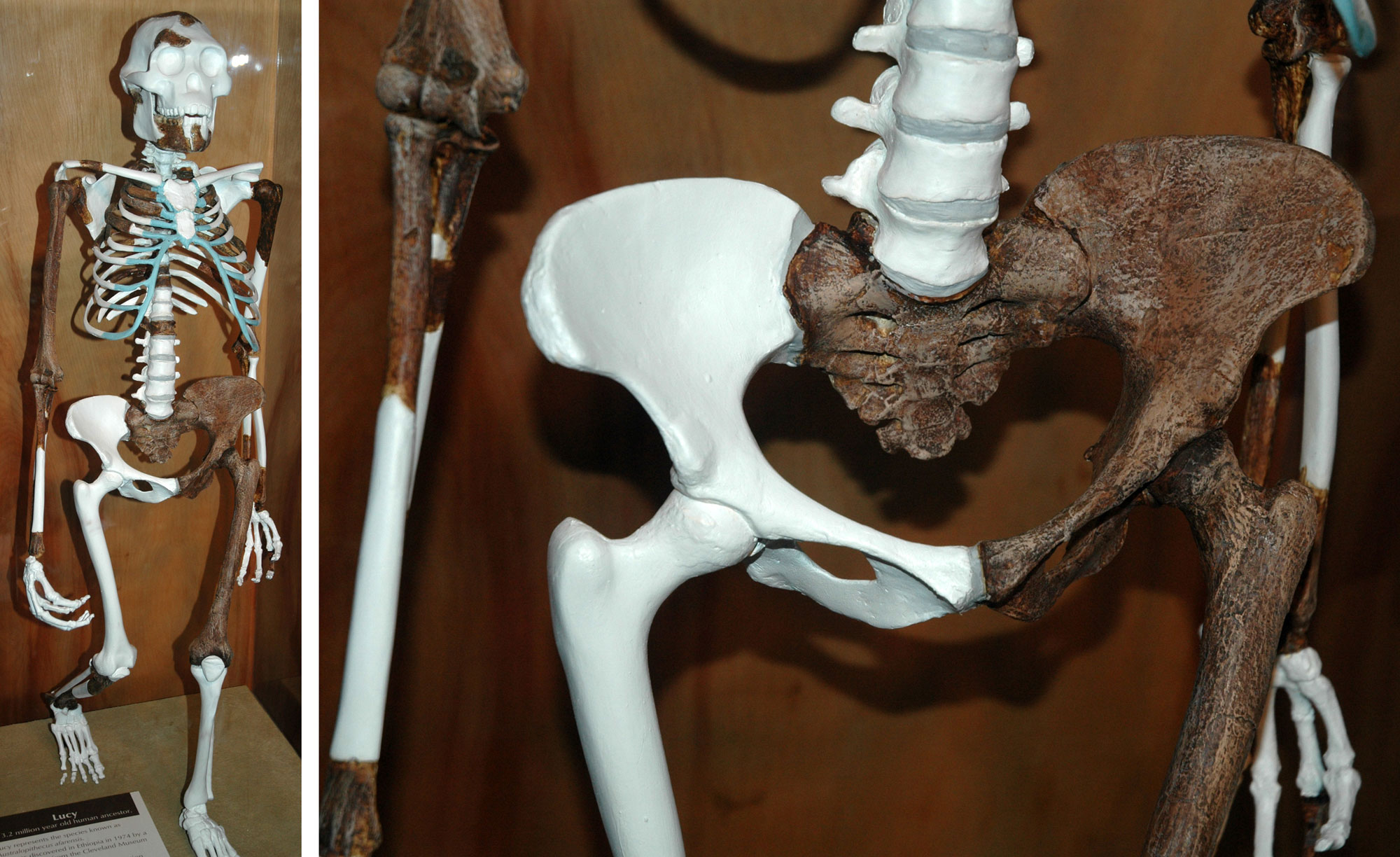
Replica of the skeleton of "Lucy," an Australopithecus afarensis from Ethiopia (left), with a close-up of the pelvis (right). Specimen on display at Cleveland Museum of Natural History, Ohio, U.S.A. Left photo and right photo by James St. John (flickr, Creative Commons Attribution 2.0 Generic license, images cropped and resized).
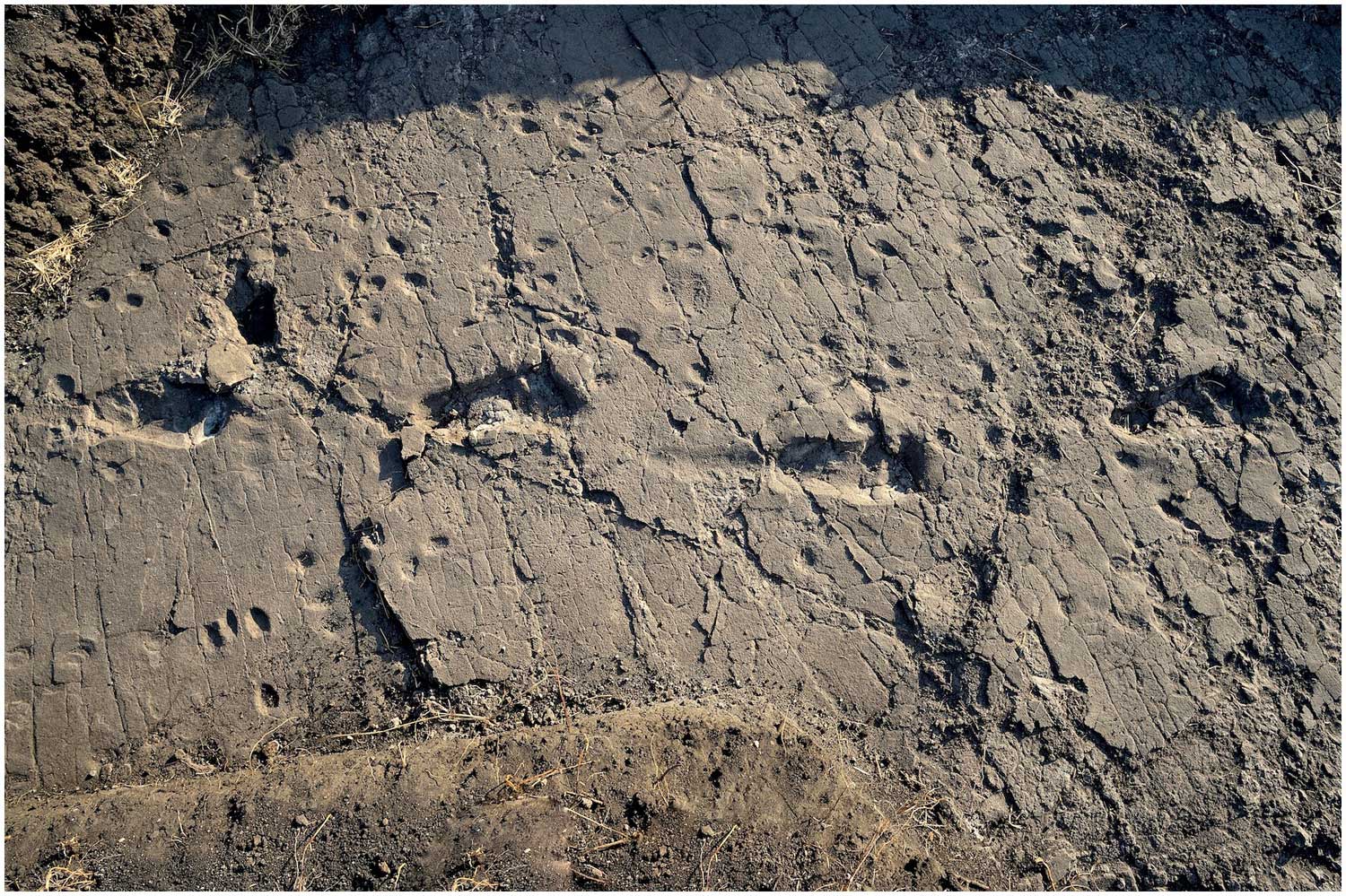
Ancient hominin footprints (the larger footprints) preserved at Laetoli, Tanzania. The Laetoli footprints are attributed to Australopithecus afarensis and are about 3.66 million years old. Source: Figure 1 from Masao et al. (2016) eLife 5: e19568 (Creative Commons Attribution 4.0 International license).
Paranthropus: nutcracker or hominin cow?
Around 2.5 to 2 million years ago, two new groups of hominins emerged, increasing the diversity of human forms present in Africa. One, the genus Homo, includes species that more closely resemble modern humans than other hominins in form or behavior. Our genus is the only one we know of to have left Africa by around 1.98 million years ago. The other, the genus Paranthropus, was characterized by wide faces, massive jaws, and large molars (cheek teeth). Three species of this genus are recognized from eastern and southern Africa.
Historically, the large teeth and jaws of Paranthropus fossils led scientists to hypothesize that they used their massive jaw muscles to crack nuts and eat other hard objects, causing the original fossil discoveries to be colloquially called “nutcracker man.” While the origins of these large jaws showed up in some earlier Australopithecus species, Paranthropus appears to have become much more specialized.
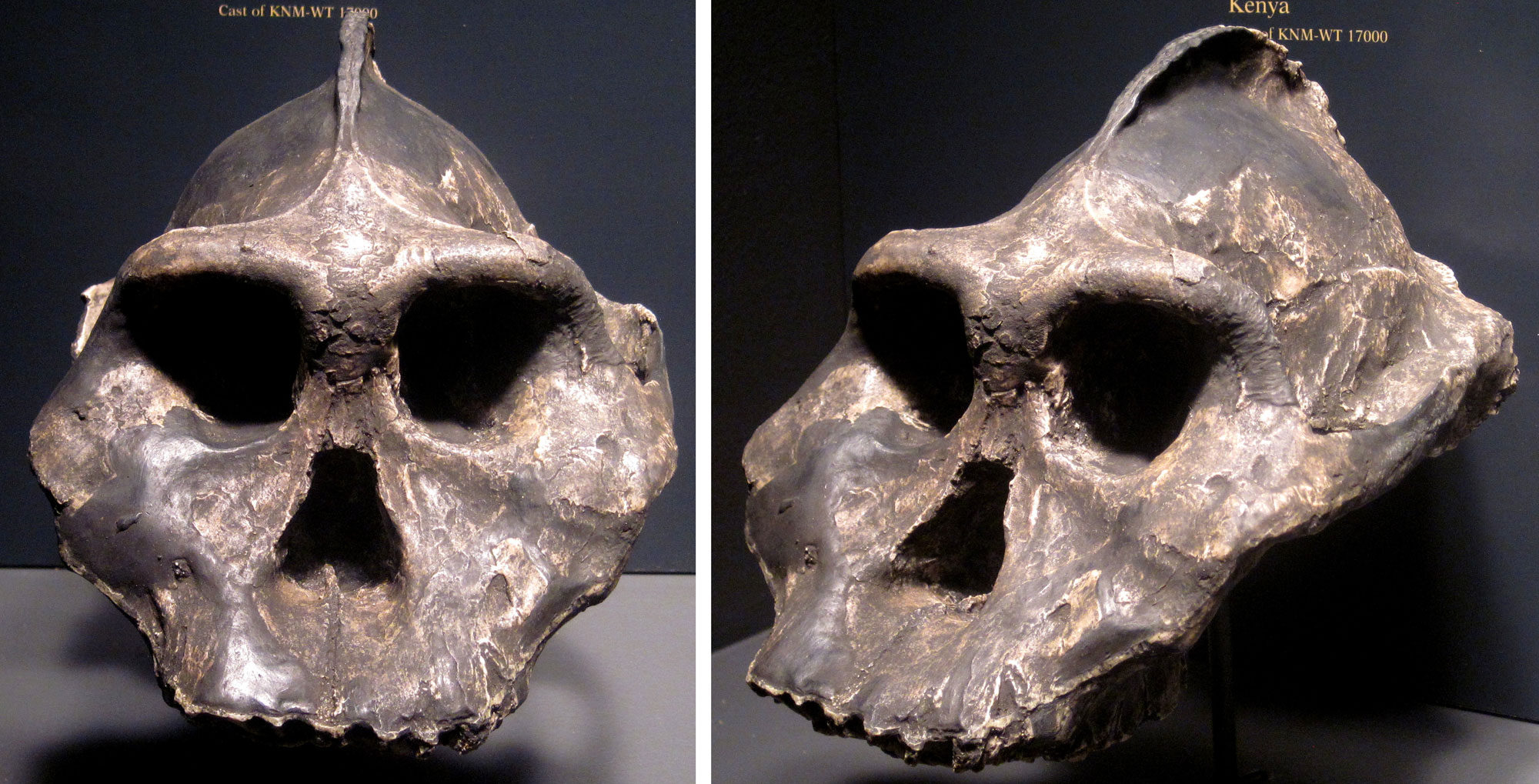
Two views of a replica of a skull of Paranthropus aethiopicus from Kenya. Specimen on display at the Field Museum of Natural History, Chicago, Illinois, U.S.A. Left photo and right photo by James St. John (flickr, Creative Commons Attribution 2.0 Generic license, images cropped and resized).
Analysis of carbon isotope data from Paranthropus fossils show that some have a strong C4 signal, indicative of a diet of grasses and sedges, while others have a more mixed feeding signal. Paranthropus boisei, from eastern Africa, is the most robust of the Paranthropus species, meaning that it has the largest teeth and strongest muscle attachments. Paranthropus boisei also has the strongest C4 signal of any hominin, indicating a diet of almost exclusively grasses and sedges.
Specimen is an artificial cast of a Paranthropus boisei skull provided courtesy of Cornell University in Ithaca, New York. Model by Hannah Teush (Sketchfab; Creative Commons Attribution-NonCommercial-ShareAlike 4.0 International license).
Another form of evidence to assess diet is dental microwear, analyzing the small scratches and abrasions that food leaves on tooth enamel. Habitually eating hard objects would lead to cracks in the enamel surface. Habitually eating grasses and sedges would lead to more scrapes and microscopic changes to the enamel surface due to the silica (in the form of phytoliths, or silica bodies) and grit in these plants. The teeth of Paranthropus boisei much more closely match the microwear pattern for grass and sedge-eaters.

Bilobed silica bodies or phytoliths in the tissue of inflorescence bracts of a kangaroo grass (Themeda caudata), an Asian grass. The genus Themeda also occurs in Africa. Source: Supplementary figure 6 from Ge et al. (2020) Frontiers in Plant Science (Creative Commons Attribution 4.0 International license, image cropped).
Altogether, the data support the idea that the large muscles of Paranthropus boisei were most likely used for consistent chewing of grasses and sedges rather than short-burst biting of hard objects. While these bony adaptations reached their height in Paranthropus boisei, there are traces of the same features in Paranthropus robustus in southern Africa, which is reconstructed as a more mixed feeder, and in earlier Australopithecus species. Therefore, grass and sedge consumption may be an integral part of ancient hominin diets, in contrast to the fruit-based diet of other apes.
Out of Africa: the origin and dispersal of Homo
Although ‘human’ characteristics like bipedal walking, larger brains, and the use of tools are present in earlier hominin species, these are most associated with the genus Homo. It was with the emergence of Homo erectus (sometimes called Homo ergaster) in Africa around 2 million years ago that brains start to get dramatically larger and that new types of tools for more specific purposes emerged. It may be no coincidence that Homo erectus is the earliest hominin species that is found outside of Africa.
Specimen is an artificial cast of a Homo erectus skull courtesy of Cornell University in Ithaca, New York. Model by Hannah Teush (Sketchfab; Creative Commons Attribution-NonCommercial-ShareAlike 4.0 International license).
Some of the earliest sites outside of Africa with evidence of hominin occupation include Dmanisi in Georgia (1.85 million years ago), Yuanmou, China (1.7 million years ago), and Sangiran on the island of Java in Indonesia (1.66 million years ago). While these sites were subject to the same climatic instability that characterized hominin evolution, all these sites are also reconstructed as being, in large part, grassland environments.
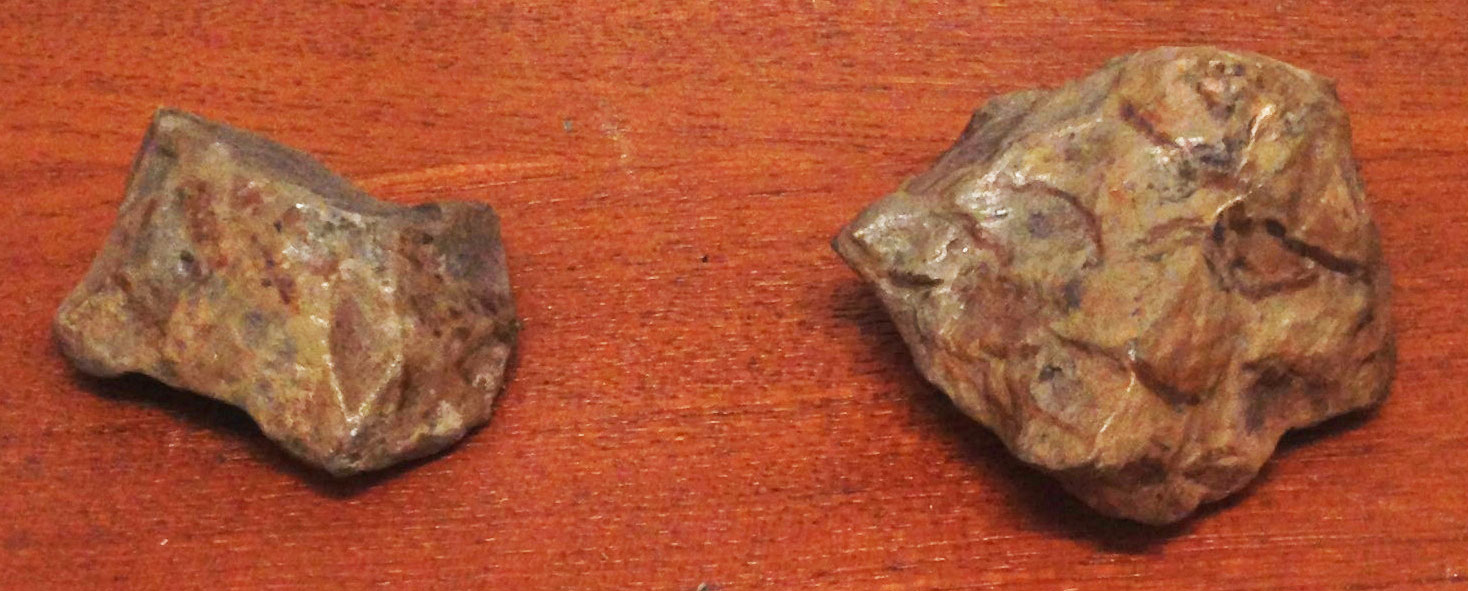
Casts (replicas) of stone tools attributed to Yuanmou Man (Homo erectus yuanmouensis) from Yunnan Province, China. Photo by SS Young (Wikimedia Commons, Creative Commons Attribution-ShareAlike 4.0 International, image cropped).
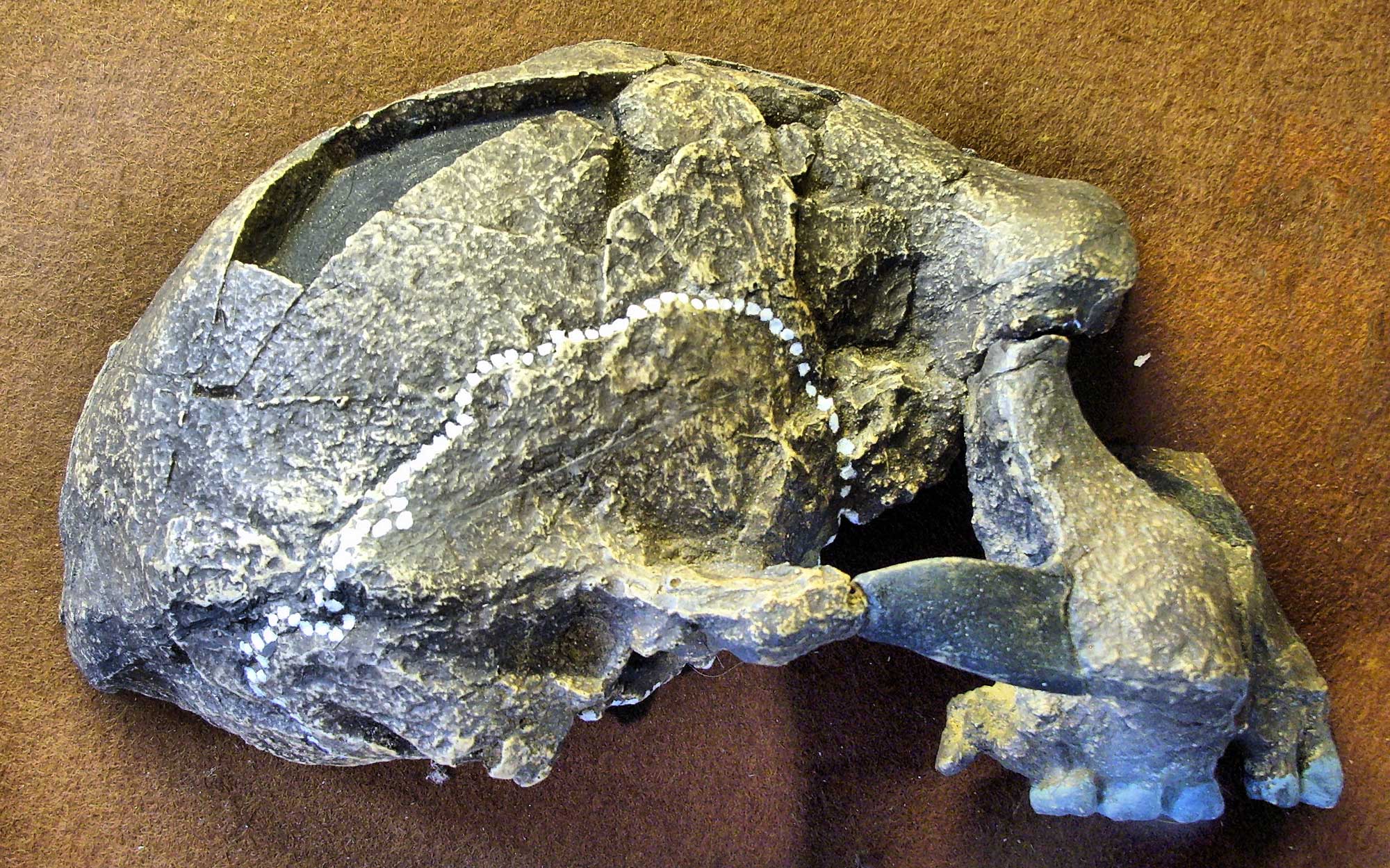
Replica of Sangiran 17, a skull of Homo erectus from Java, Indonesia. Photo by Gerbil (Wikimedia Commons, Creative Commons Attribution-ShareAlike 3.0 Unported license, image cropped and resized).
Whether hominins exited Africa across the Arabian sea or through the Sinai Peninsula is debated. Climatic reconstructions of the eastern Sahara show that wide grassland corridors and extensive lakes would have been present during wetter periods, allowing for migration out of Africa. The earliest archaeological evidence of boats or other overseas crossing is not until more recently, less than 100,000 years ago. While the lack of archaeological evidence does not automatically mean that crossing out of Africa via boat is impossible, an overland crossing would have been much more likely.
Resources
Websites
Other pages on the Grasses website
Types of evidence used to study ancient grasses
Additional resources from the Paleontological Research Institution
Digital Atlas of Ancient Life: Biogeochemical Analysis and Paleoecology (by Jansen Smith)
Digital Atlas of Ancient Life Virtual Collection: Hominids
Other websites
Behind the Science: C3 or C4, which one are you? (H. Gregory, The Leakey Foundation): https://leakeyfoundation.org/2015behind-the-science-c3-or-c4-which-one-are-you/
Smithsonian National Museum of Natural History Human Origins Program: https://humanorigins.si.edu/research/climate-and-human-evolution/climate-effects-human-evolution
Articles & reports
Wayman, E. 2012. Early hominids had a taste for grass. Smithsonian Magazine, 14 November 2012. https://www.smithsonianmag.com/science-nature/early-hominids-had-a-taste-for-grass-122066346/
Scientific articles & book chapters
Behrensmeyer, A. K., and K. E. Reed. 2013. Reconstructing the habitats of Australopithecus: Paleoenvironments, site taphonomy, and faunas. Pp.41-60 in K. Reed, J. Fleagle, and R. Leakey (eds.), The paleobiology of Australopithecus. Vertebrate Paleobiology and Paleoanthropology. Springer, Dordrecht. https://doi.org/10.1007/978-94-007-5919-0_4
Cerling, T. E., N. E. Levin, J. Quade, J. G. Wynn, D. L. Fox, J. D. Kingston, R. G. Klein, and F. H. Brown. 2010. Comment on the paleoenvironment of Ardipithecus ramidus. Science 328 (5982): 1105. https://doi.org/10.1126/science.1185274
Cerling, T. E., E. Mbua, F. M. Kirera, F. K. Manthi, F. E. Grine, M. G. Leakey, M. Sponheimer, and K. T. Uno. 2011. Diet of Paranthropus boisei in the early Pleistocene of East Africa. Proceedings of the National Academy of Sciences 108(23): 9337-9341. https://doi.org/10.1073/pnas.110462710
Lahr, M. M. 2010. Saharan corridors and their role in the evolutionary geography of ‘Out of Africa I’. Pp. 27-46 in J. Fleagle, J. Shea, F. Grine, A. Baden, and R. Leakey (eds.), Out of Africa I. Vertebrate Paleobiology and Paleoanthropology. Springer, Dordrecht. https://doi.org/10.1007/978-90-481-9036-2_3



